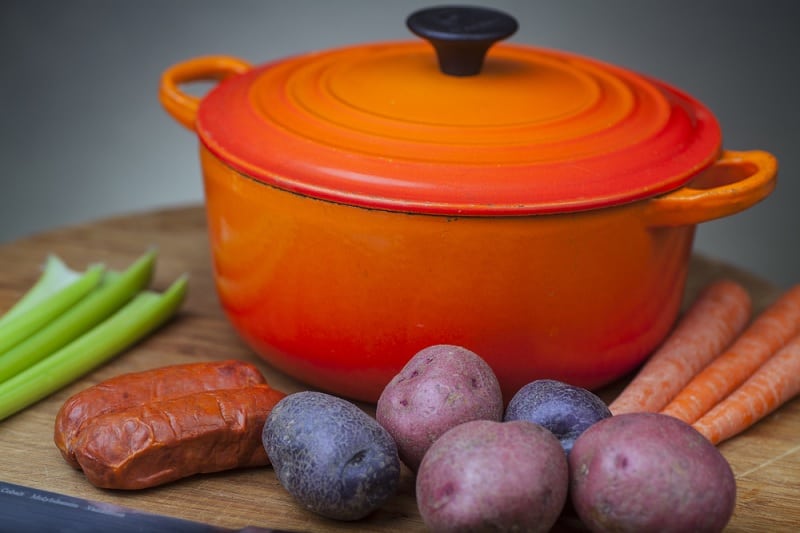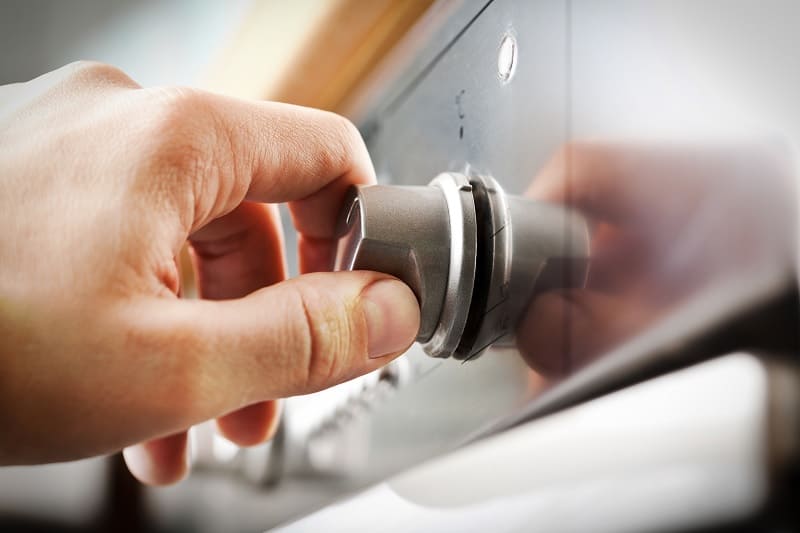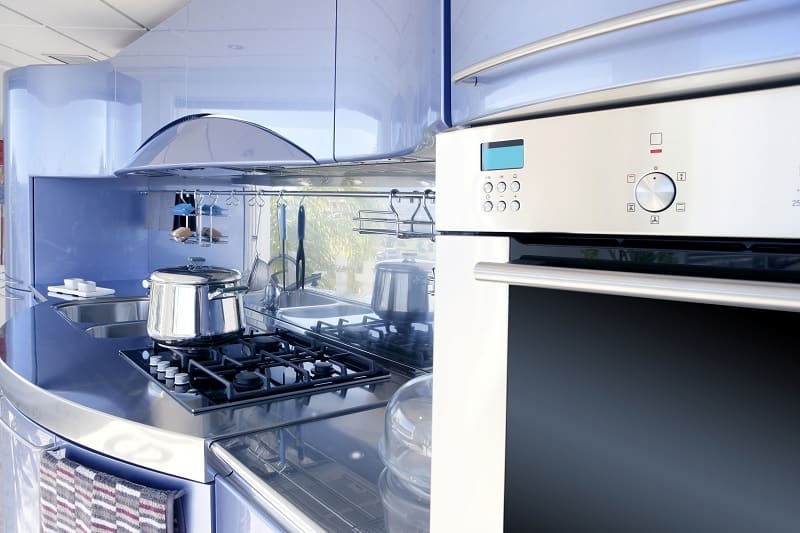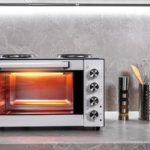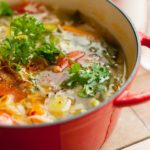Dutch ovens have been a useful tool for both indoor and al fresco cooking for the better part of three-hundred years, and are the perfect option for slow-cooked meals, such as casseroles, stews, and homemade soups. You can also roast various foods, and even bake bread…
So, it’s safe to say there’s virtually nothing a Dutch oven can’t do!
Their key selling point is arguably their versatility, which allows them to be used both on top of and inside your cooker. So, if you’re in the market and are wondering what the best Dutch ovens in the UK are, all will be revealed…
The Best Dutch Ovens in the UK
1. Lodge EC6D32 Enameled Dutch Oven
Capacity: 6 quarts (6.8 litres)
Coming with a choice four colours (indigo, lagoon, midnight chrome, and storm blue), this Lodge enamelled Dutch oven is spacious and can cook foods at a temperature that goes up to 260 degrees Celsius (500 Fahrenheit).
It’s also dishwasher-friendly, which can take the hassle out of your tough slow-cooked stains that have caked themselves to the inside of the enamel.
This Dutch oven is made of cast iron, which is one of the most robust, reliable cooking materials. It’s coated in enamel, meaning you won’t need to season it (as is the case with pure cast iron products) and is safe to come into contact with warm, soapy water.
Enamel can be prone to chipping, which is something a buyer needs to bear in mind, but overall, users of this Lodge Dutch oven are impressed with both its manufacturing and reliability – not to mention the choice of colours available!
2. Amazon Basics Cast Iron Covered Dutch Oven
Capacity: 5.6 litres
Stylish yet simple, this Amazon Basics Dutch oven comes in an option of four colours (white, red, green, and blue).
It is favourably reviewed by many users for being as good as more high-brow brands such as Le Creuset, so it’s safe to say this Dutch oven is extremely good value for money.
A few of its negative points, however, include that it is rather heavy and tough to handle. Also, the version labelled ‘white’, is actually more of a cream colour, which may be worth factoring in if your current cookware is white and you want it to match.
3. Lodge L8DD3 4.73 litre Dutch Oven
Capacity: 4.73 litres
A more traditional-looking Dutch oven, this Lodge L8DD3 is pre-seasoned and can be used on all cooker types (including induction), and despite being enamel coated, is resistant to all utensil types (including metal).
It isn’t labelled as dishwasher-friendly, which can be a nuisance to some, but it can be washed in warm water, and boasts a lifespan of up to one-hundred years.
One of the key features of Dutch ovens in general is that they are brilliant for baking bread, and many users of this Lodge model are singing its praises for that reason alone.
However, this particular product has very mixed reviews in terms of its quality. Some say it will “last a lifetime” and another has knocked it for being… not great.
4. Puricon Cast Iron Casserole Dish
Capacity: 5.2 litres
This Puricon Dutch oven is a good size, and ideal for bigger households.
However, it’s worth bearing in mind that the base of this particular Dutch oven isn’t very even, so it might not be suitable for induction hobs, or may create heat spots within the base, which subsequently may affect your food.
Reviews from users are largely very favourable, with many citing it as great value for money, and it being very easy to clean.
It’s been advised by the manufacturer to avoid using metal utensils with this particular Dutch oven.
5. Le Creuset Signature Round Casserole Dish
Capacity: 6.7 litres
Le Creuset is one of the top cookware brands, and for that alone, the price of this Signature cast iron casserole dish is significantly higher than the others on this list.
That said, you’ll get your money’s worth because their products are famed for their sturdiness.
Plus, with its 6.7-litre capacity, you can feed up to eight people with this Dutch oven. It’s also dishwasher-safe, and has no limit on temperature exposure.
The only grumble from users really is that it is incredibly weighty. Though, for the size and material, that’s to be expected.
Dutch Ovens vs Casserole Dishes – What’s the Difference?
Simply put, the difference between a Dutch oven and a casserole is that a Dutch oven is the more versatile of the two. A casserole dish is designed to go in the oven, and that’s it.
But a Dutch oven can go both inside the cooker and on top of the hob, making it ideal for cooking many different foods.
Read out guide to the differences between Dutch ovens and casserole dishes for more detail.
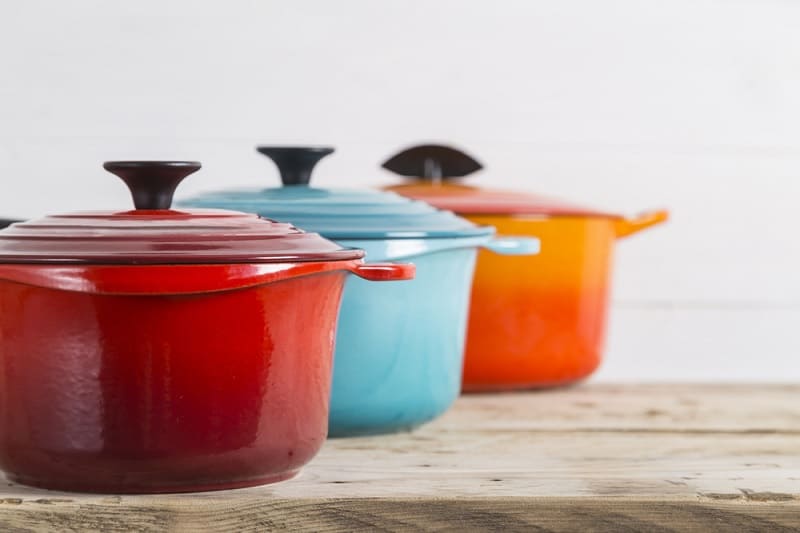
The History of the Dutch Oven
The Dutch oven was popularised by an Englishman named Abraham Darby in the 1800s. Darby travelled to the Netherlands to study metalsmith practices, particularly on the subject of brass.
The Dutch methods of crafting gave him the idea of the Dutch oven, but instead of using brass, he used cast iron, which was a cheaper material.
Traditionally, Dutch ovens would have had three little legs, as well as a handle that allowed them to be dangled over a fire.
Dutch ovens haven’t dwindled in popularity, due to their renowned versatility and that they are useful for outdoor activities, such as camping.
What Are Dutch Ovens Made From?
As we mentioned above, traditionally Dutch ovens were made from cast iron, which is still a popular material for cooking, owing to its robust nature, its ability to draw heat very quickly, its longevity, and that it’s a budget-friendly metal.
Most Dutch ovens nowadays are still made from cast iron, but many are coated in enamel, which makes them much easier to clean. They also do not need to be seasoned because no food will come in direct contact with the cast iron.
You can also get Dutch ovens in other materials, including stainless steel. Traditionally, Dutch ovens didn’t contain an enamel coating. To be technical, an enamel-coated cooking pot is actually called a French oven, otherwise known as cocotte.

Dutch Oven FAQs
Can you put a Dutch oven in the dishwasher?
If your Dutch oven has an enamel coating, you can usually clean it in the dishwasher. If it is pure cast iron, it shouldn’t come into contact with water, and should be regularly seasoned.
What should you look for when buying a Dutch oven?
Consider the size you require. If you cook for many mouths, it is wise to choose a Dutch oven that has a capacity of over five litres.
Material-wise, that is really down to personal preference. Buying one with an enamel coating will be easier to clean (and won’t require seasoning). However, enamel is prone to chipping, so in terms of longevity, a pure cast iron one will probably outlive you.
Are Dutch ovens non-stick?
Technically, no. Dutch ovens (enamelled or otherwise) do not contain non-stick chemicals, such as Teflon). However, if well-maintained, and if food isn’t cooked on too high a temperature, your Dutch oven’s enamel coating should act as non-stick, and should be easy to keep clean.
How do you avoid damaging a Dutch oven?
- Cooking on extreme heat – Dutch ovens are designed for slow cooking, and to retain heat, so going OTT with your temperature dials will burn your food/cause it to mould to the sides of the pan.
- Metal utensils – This is particularly important with most enamel-coated Dutch ovens. Metal utensils are notorious for chipping coatings, and will effectively shorten the lifespan of your Dutch oven.
- Being austere with oil or butter, or not using it at all – As mentioned earlier, Dutch ovens aren’t technically non-stick, so they will require cooking lubricants.
Conclusion
Dutch ovens are a great addition to any kitchen, based on their versatility alone. They’re also beneficial to those who enjoy outdoor adventuring, such as camping and hiking.
While they often look identical to casserole dishes, they exceed the basic casserole dish because they can be used both on top of your stove and inside the oven.
Many Dutch ovens nowadays are still made of cast iron, but often come with an enamel coating, making them easy to clean and not in need of seasoning.
But if you’re still stuck on which option to go with, allow us to lend our expertise. Here at Chef’s Pick, we love the Lodge EC6D32 enamelled Dutch oven. It is reasonably-priced, robust, and those colours are pretty funky!

Clara is a freelance writer and former chef. Though she may have hung up her apron, her love of food and cooking is still going strong! When she’s not whipping up a verbal storm, she’ll be in her kitchen sipping wine and whipping up a culinary storm.

